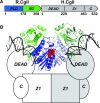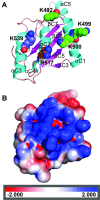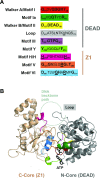The H-subunit of the restriction endonuclease CglI contains a prototype DEAD-Z1 helicase-like motor
- PMID: 29471489
- PMCID: PMC5861437
- DOI: 10.1093/nar/gky107
The H-subunit of the restriction endonuclease CglI contains a prototype DEAD-Z1 helicase-like motor
Abstract
CglI is a restriction endonuclease from Corynebacterium glutamicum that forms a complex between: two R-subunits that have site specific-recognition and nuclease domains; and two H-subunits, with Superfamily 2 helicase-like DEAD domains, and uncharacterized Z1 and C-terminal domains. ATP hydrolysis by the H-subunits catalyses dsDNA translocation that is necessary for long-range movement along DNA that activates nuclease activity. Here, we provide biochemical and molecular modelling evidence that shows that Z1 has a fold distantly-related to RecA, and that the DEAD-Z1 domains together form an ATP binding interface and are the prototype of a previously undescribed monomeric helicase-like motor. The DEAD-Z1 motor has unusual Walker A and Motif VI sequences those nonetheless have their expected functions. Additionally, it contains DEAD-Z1-specific features: an H/H motif and a loop (aa 163-aa 172), that both play a role in the coupling of ATP hydrolysis to DNA cleavage. We also solved the crystal structure of the C-terminal domain which has a unique fold, and demonstrate that the Z1-C domains are the principal DNA binding interface of the H-subunit. Finally, we use small angle X-ray scattering to provide a model for how the H-subunit domains are arranged in a dimeric complex.
Figures







Similar articles
-
CgII cleaves DNA using a mechanism distinct from other ATP-dependent restriction endonucleases.Nucleic Acids Res. 2017 Aug 21;45(14):8435-8447. doi: 10.1093/nar/gkx580. Nucleic Acids Res. 2017. PMID: 28854738 Free PMC article.
-
DNA cleavage by CgII and NgoAVII requires interaction between N- and R-proteins and extensive nucleotide hydrolysis.Nucleic Acids Res. 2014 Dec 16;42(22):13887-96. doi: 10.1093/nar/gku1236. Epub 2014 Nov 27. Nucleic Acids Res. 2014. PMID: 25429977 Free PMC article.
-
A residue of motif III positions the helicase domains of motor subunit HsdR in restriction-modification enzyme EcoR124I.J Mol Model. 2018 Jun 26;24(7):176. doi: 10.1007/s00894-018-3722-8. J Mol Model. 2018. PMID: 29943199
-
Structure and mechanism of Escherichia coli RecA ATPase.Mol Microbiol. 2005 Oct;58(2):358-66. doi: 10.1111/j.1365-2958.2005.04876.x. Mol Microbiol. 2005. PMID: 16194225 Review.
-
The nucleotide excision repair protein UvrB, a helicase-like enzyme with a catch.Mutat Res. 2000 Aug 30;460(3-4):277-300. doi: 10.1016/s0921-8777(00)00032-x. Mutat Res. 2000. PMID: 10946234 Review.
Cited by
-
Highly regulated, diversifying NTP-dependent biological conflict systems with implications for the emergence of multicellularity.Elife. 2020 Feb 26;9:e52696. doi: 10.7554/eLife.52696. Elife. 2020. PMID: 32101166 Free PMC article.
References
Publication types
MeSH terms
Substances
Grants and funding
LinkOut - more resources
Full Text Sources
Other Literature Sources
Molecular Biology Databases

